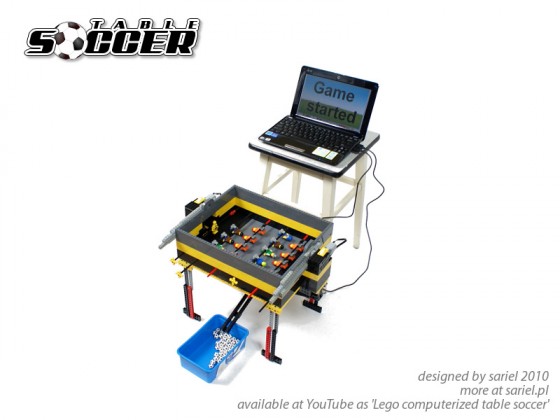Simple table soccer game for two players, computerized and controlled with the WeDo kit.
Datasheet:
Completion date: 28/06/2010
Power: electric (Power Functions)
Dimensions: length 54 studs / width 36 studs (not including axles) / height 45 studs
Weight: 1.88 kg
Motors: 2 x PF Medium
A spontaneous build which started as a joke with my co-workers. It’s a simple realization of the classic table soccer game adjusted for Lego minifigures and automated with WeDo components. Since I have completely no interest in soccer whatsoever, I didn’t pay real attention to keeping the number of players or size of the pitch accurate. My goal (sic!) was rather to demonstrate an innovative use of the WeDo components that to render a realistic model of a table soccer game.
Counting the game score and returning balls to a box are both fully automated. The actual game remains, obviously, fully manual, with eight players on two axles for each team, and a single goalkeeper on a separate axle. The goalkeeper’s sideways movement is limited so that the gate is not accidentally left empty. The players’ axles use different colors for improved distinction. The game is played on a pitch paved with large tiles and surrounded with solid walls build of classic bricks. Both gates have WeDo motion sensors inside, arranged in such a way that incoming ball must pass in front of the sensor. The ball then falls into a simple system of hanging rails, with one rail for each gate and a single central rail that receives all balls and directs them to a box.
The motion sensors trigger a simple algorithm: there is a sound played, an announcement displayed on computer’s screen, and then a second sound follows. Finally, there is a sliding beam above the respective gate which is moved by a given distance. Both gates have such beams above them, each with a sticker representing numbers from 0 to 10. The beam is concealed behind a wall with a 2×1 stud window, and the desired number is shown through the window. Every time the algorithm is triggered, the beam is moved by a single number, on an obvious assumption that only one goal can be scored at a time. Both beams are controlled by PF Medium motors with a substantial gear reduction – it is possible to control the motor’s speed precisely with the WeDo software and thus eliminate the need for a gear reduction, but it was easier to keep the beam’s movements accurate with a high gear reduction. Additionally, there is a clutch gear at each motor – thanks to this, it is possible to reset the beams’ positions with a single key press, regardless of their current position. Upon pressing R, there is an announcement displayed, both beams are returned to the ‘zero’ position, and once the procedure is completed another announcement follows.
The construction has seen little of actual gameplay, as it was completed during a holiday weekend and it was difficult to find another player. It was, however, successful in using the WeDo elements exactly how I intended to. Additionally, it was my first opportunity to shoot a video using my new camera with a high-speed filming mode. Therefore a large portion of the final video is composed of a footage shot at 210 FPS.
Photos:
Video:
Click here to view the embedded video.
Media reference:
Ekstra Bladet (Danish only), Engaget.com, Fascinating LEGO Model of the Day, Gadgets Now, Gizmologia (Spanish only), Hobby Media (Italian only), Hogargeek (Spanish only), Makezine, Omgunmen (German only), Sema Geek (French only), Technabob, Technoblogia (Polish only)
































